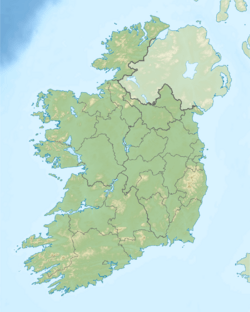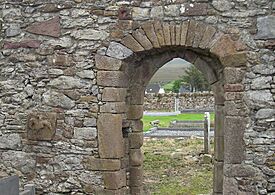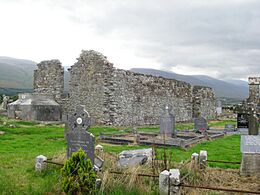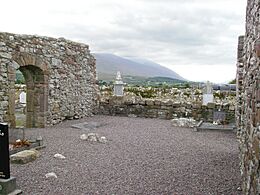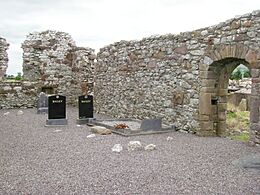Annagh Church facts for kids
Quick facts for kids Annagh Church |
|
|---|---|
|
Teampall Eanaigh
|
|
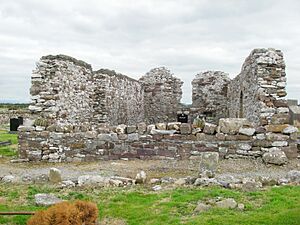
Annagh Church looking east
|
|
| 52°14′54″N 9°45′17″W / 52.248452°N 9.754696°W | |
| Location | Annagh, Tralee, County Kerry |
| Country | Ireland |
| Denomination | Catholic (pre-Reformation) |
| Architecture | |
| Functional status | Ruined |
| Style | Anglo-Norman |
| Years built | Between 12th-15th centuries AD |
| Administration | |
| Diocese | Ardfert and Aghadoe |
Annagh Church is an old, ruined church in County Kerry, Ireland, close to the town of Tralee. It's also a special place called a National Monument, which means it's protected because of its history. This church was built a long, long time ago, sometime between the 1100s and the 1400s. Inside, you can find a cool, old carving of a knight on horseback. The church is surrounded by an old cemetery with many gravestones. There are also other ancient sites nearby, like old forts and tall standing stones.
Contents
Annagh Church: A Look Back in Time
Annagh Church is located about 3.6 kilometers (2.2 miles) southwest of Tralee, in County Kerry, Ireland. It's a roofless, ruined building found at the northern end of its old burial ground. The church has a simple, rectangular shape, measuring about 14 meters (46 feet) long and 5.5 meters (18 feet) wide. Even though it's very old, it's still in good condition.
What Does Annagh Church Look Like?
The church was built using local stones like sandstone and limestone. There's a small stone carving inside on the south wall, also made of sandstone. Some repairs were done to the church walls in the early 1900s. The inside of the church is covered with gravel and has several old and new graves.
The wall on the eastern side of the church is now shorter, about the same height as the side walls. It has one window. The western wall was rebuilt in the 1900s and is now less than 1 meter (3 feet) tall. It also has one window.
The northern wall is still mostly its original height, but it has a large gap. The western part of this wall is also shorter now. There are no windows on the north wall.
The south wall is almost its full height and has one window opening. The main entrance doorway on this wall is very well-preserved. It has a special 3-point arch and a decorative stone border called a drip-moulding, which is an old Anglo-Norman style. Just inside the doorway, there's a small hollow in one of the wall stones that was used as a holy-water stoup. Next to this doorway, on the inside wall, is the sandstone carving of a knight on horseback.
The Mysterious Sandstone Carving
On the inside of the south wall, right next to the doorway, you'll find a small sandstone carving built into the wall. It's a rough image of a man riding a horse and holding a weapon in his right hand. This carving is about 46 centimeters (18 inches) tall, 41 centimeters (16 inches) wide, and 18 centimeters (7 inches) thick. The head and left shoulder of the knight are missing. Experts think this carving might be from the 1300s and was likely carved into the church wall when it was first built.
A Glimpse into Annagh Church's Past
Annagh Church was built sometime between the 1100s and the 1400s. The area around the church is very old, with many ancient sites like Tonakilla Fort (a ringfort) and standing stones. Records from the 1800s suggest that Annagh Church was already abandoned and in ruins by the year 1756.
About half a mile away, in the village of Blennerville, a new church was built in 1818 to replace the old Annagh Church. Later, in 1877, the Blennerville church area joined with the Tralee church area. The new church was named St. Anna's, taking its name from the old 'Annagh' place name.
Gallery


